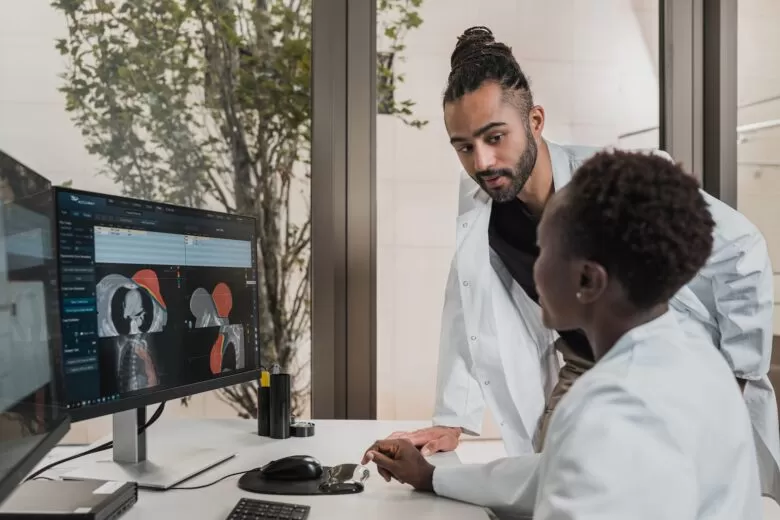In a world after COVID, most conventional ideas of healthcare have been changed. The healthcare industry has completely changed from online consultations to major institutions turning to technology to facilitate diagnosis and patient management.
The internet has empowered more people than ever before. Giving them relevant information gives patients much more confidence to make health decisions. In addition, having medical information available at their fingertips gives patients and their loved ones tools to provide better care and manage their diseases more effectively.
Here are some ways in which medical facilities benefit from software;
10 ways medical facilities can benefit from software
- Medical visualization Software:
We all know someone terrified to get their blood drawn or has difficulty getting their blood drawn due to thin veins. Visualization devices such as AccuVein help find patients’ veins easily for blood draws. This not only speeds up the process but also increases patient satisfaction.
True 3D software by a company known as Echopixel helps prepare three-dimensional models specific to patient anatomy. This helps surgeons prepare for complex procedures.
- Managing Patient records:
Electronic records have revolutionized health care like no other. Having patient databases available helps doctors follow the patient and collect patient statistics, responses to different treatments, and overall study the effect of different management strategies. All of this data helps clinicians make more informed decisions regarding their patient’s health in the future.
You may have heard of the LIS system, a software solution that helps manage patient data, including laboratory testing, and helps coordinate the workflow.
- Software in diagnosis:
Pittsburgh University was the first to introduce diagnostic software back in the 1970s. Since then, we have seen a large number of software that can help clinicians and physicians to make more precise and fast decisions. In addition, this technology uses more recent research or data that might not be available to physicians.
It also makes it easier for people who may not have access to quality healthcare research and learn about their symptoms to figure out what should raise red flags. Diagnosaurus, Face2gene, and DXplain are some examples of such software.
- A solution for radiology:
The importance of radiology in diagnosing any medical or surgical condition can never be undermined. While many doctors may have a basic understanding of radiology, most rely on radiological reporting for proceeding with a management plan. For those interested in pursuing a career in this vital field, obtaining comprehensive insights on w-radiology education and programs can be a great starting point. AI1 all-in-one solution is software that receives radiological scans and automatically analyses them with human-level accuracy. It has millions of scans stored in its database and uses it to study scans and look for various clinical findings, helping reduce the workload on radiologists. The integration of advanced radiological education and training can further enhance the capabilities of healthcare professionals in leveraging technology for better patient outcomes.
Wearable technology has revolutionized patient monitoring. For example, these devices can help monitor a patient’s cardiac rhythm or blood glucose levels. These records help physicians alter the patient’s medications according to their requirements. These devices also help identify the more high-risk patients, and they can, in turn, counsel them in more detail.
- All labs in one place
Different laboratories and hospitals upload lab reports on an online database. Patients are given a password that allows them to access their labs from the convenience of their homes.
Having this software available in hospitals also helps doctors stay updated with their patient’s labs during hospital rounds and stay on top of any changes in condition.
- Scheduling appointments:

Most hospitals these days use software to schedule appointments for consultations, radiological scans, or minor procedures. This has made the entire process more efficient and less time-consuming, reducing the administrative workload in hospitals.
Most people can book their appointments from the comfort of their homes and avoid getting in unnecessary queues. This also saves useless visits to the hospital or lab to book an appointment.
- Managing billing:
Most patients or their families may be concerned with the cost and be confused about the financial load it may put on them. However, having an online database where all information is made available to the patient at the cost of different lab investigations, radiological scans, and therapeutic options reduces anxiety and helps them be better prepared.
Most apps that schedule appointments also have in-built billing options. This makes making payments a lot smoother for the patients or their families.
- Medical research software:
Websites like PubMed and Research gate have revolutionized research in healthcare. Instead of manually going through multiple volumes of lengthy journals, medical researchers have access to the latest information and data. Medicine is highly dependent on research and sharing data. This helps doctors find correlations between their patients and others around the world.
- Telemedicine software:
Telemedicine software helps doctors and clinical practitioners carry out their appointments online. Not only does it make the process more efficient, but it also reduces useless patient visits to the hospital and prevents exposing them to more infections. This also solves the issue of accessibility for many patients and speeds up consultations for general physicians.
Conclusion:
It is clear how important technology and software are in medicine, just like in any other field. It is safe to say healthcare software industry is thriving, especially in a post-COVID world. Not only does software reduce workload and increase efficiency, but it also helps accelerate medical advancements that wouldn’t be possible manually.





























